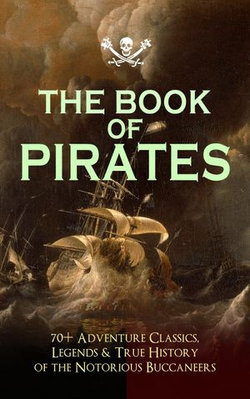Enjoy the best sea adventures, treasure hunt tales and bloody battles, along with learning the truth behind the legends, the real life stories that inspired so many writers and produced so many beloved classics: History of the Robberies and Murders of the Most Notorious Pirates (Captain Charles Johnson) The Book of Buried Treasure Treasure Island (R. L. Stevenson) Blackbeard: Buccaneer (R. D. Paine) Pieces of Eight (Le Gallienne) Captain Singleton (Defoe) Gold-Bug (Edgar Allan Poe) Hearts of Three (Jack London) The Dark Frigate (C. B. Hawes) Isle of Pirate's Doom (Robert E. Howard) Swords of Red Brotherhood (Howard) Queen of Black Coast (Howard) Barbarossa—King of the Corsairs Black Vulmea (Howard) Afloat and Ashore (James F. Cooper) Homeward Bound (Cooper) Red Rover (Cooper) Facing the Flag (Jules Verne) A Pirate of the Caribbees (H. Collingwood) Pirate Gow (Daniel Defoe) The King of Pirates (Defoe) The Pirate (Walter Scott) Rose of Paradise (Howard Pyle) Captain Sharkey (Arthur Conan Doyle) The Pirate (Frederick Marryat) Three Cutters (Marryat) Madman and the Pirate (R. M. Ballantyne) The Offshore Pirate (F. Scott Fitzgerald) Coral Island (Ballantyne) Under the Waves (Ballantyne) Pirate City (Ballantyne) Captain Boldheart (Dickens) Master Key (L. Frank Baum) A Man to His Mate (J. Allan Dunn) Tales of the Fish Patrol (Jack London) Robinson Crusoe (Defoe) Peter Pan and Wendy (J. M. Barrie) Mysterious Island (Jules Verne) Count of Monte Cristo (Dumas) Ghost Pirates (W. H. Hodgson) The Pirate Island (H. Collingwood) Among Malay Pirates The Capture of Panama, 1671 The Malay Proas (James F. Cooper) The Daughter of the Great Mogul (Defoe) Morgan at Puerto Bello The Ways of the Buccaneers Narrative of the Capture of the Ship Derby, 1735 (Captain Anselm) The Fight Between the Dorrill and the Moca Jaddi the Malay Pirate The Terrible Ladrones The Female Captive The Passing of Mogul Mackenzie Sea-Wolves of the Mediterranean Pirates of Panama ...



Share This eBook: